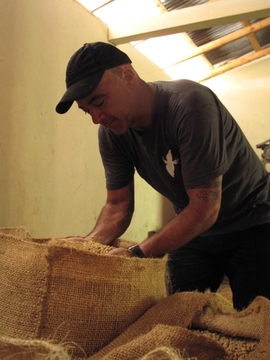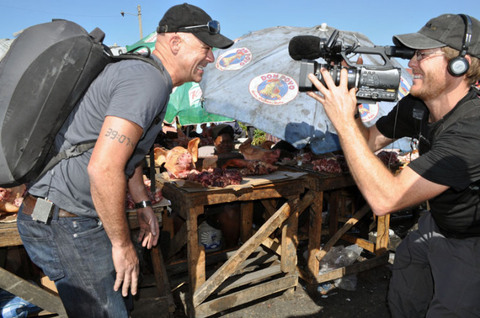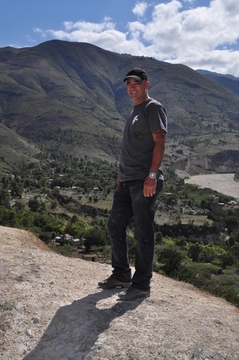The Light from the TV Shows: A Chat with Todd Carmichael (“Dangerous Grounds”)
If you’re a regular viewer of the National Geographic Channel, then you might be familiar with Todd Carmichael for his Antarctic travelogue, “Race to the Bottom of the Earth,” but if you’re a connoisseur of all things caffeinated, then it’s more likely that you’ll know him for La Colombe, a business endeavor which has allowed the entrepreneur to dedicate his life to finding, selling, and – in a few select cities around the world – serving up some of the world’s best coffees. Now, Travel Channel is giving Carmichael the opportunity to show their viewers just how hard he’s willing to work to provide people with the beans to make the finest possible cup o’ joe.
Carmichael chatted with Bullz-Eye about the origins of his series – the cleverly-titled “Dangerous Grounds,” which debuts on November 5 at 10 PM – and how his coffee-hunting adventures have changed since he’s had to start traveling with a cameraman by his side, also offering up a few suggestions of where casual coffee fans can start the process of expanding their palate to more unique tastes. By the way, for the record, Carmichael admitted to being “a little juiced up on caffeine” during our conversation, having just come off a lengthy coffee-tasting session, but as someone who’s perpetually hopped up on caffeine myself, he sounded perfectly normal to me.

Bullz-Eye: First of all, I was able to check out the first episode of “Dangerous Grounds” before our chat, and I really enjoyed it.
Todd Carmichael: Oh, great! That was Haiti, right?
BE: Yep, sure was.
TC: Oh, excellent. Yeah, that was a great adventure.
BE: Well, to jump way back to the very beginning, when did your love of / addiction to caffeine first begin?
TC: [Laughs.] Oh, you know, it’s just like any other addiction: it’s hard to tell the actual moment. But I definitely really remember the first time I said, “Okay, this is what I’m going to do.” But I did it for a different purpose. I was 15 years old, and I was just one of these obsessed little distance runners. It was really distance running that got me to college, to the University of Washington. And I read this article in Runner’s World Magazine at the time, and there was a guy named Bill Rogers, he was kind of like the reigning champion of the Boston Marathon, and he wrote an article about his use of caffeine and coffee and how it affected his running. And, you know, at that time, everyone kind of thought of coffee as a dangerous thing, as if it was like cigarettes or something like that. Needless to say, the next morning I brewed my very first pot…and drank the whole thing. [Laughs.] And I haven’t really stopped doing that since.

BE: So what made you actually go into the coffee business?
TC: Well, first, I think coffee chose me. And then later on, I chose coffee. Like I said, I went off from a small town on the eastern side of Washington and went to the big city to college, and although I had a full scholarship for distance running, I still needed to have a little extra money, so I started looking for jobs. But I was a farm boy, and it wasn’t such an easy thing to come by, because I didn’t really know how to do anything other than, like, drag hay bales and grain sacks around. [Laughs.] But I finally found a job, and it was in coffee. And it didn’t take me long to kind of fall in love with the exotic idea of…I mean, I looked at all these bags, and they weren’t like the bags back home. They had names on ‘em like Tanzania and Rwanda, and it just really got me dreaming. And when I finished my education, I pursued for a couple of years tax law, of all things. That’s what I’d studied to do. But I missed coffee. So then, through my twenties, I saved all my money in order to start my own coffee company, which I did at the end of ’93 with my best friend. And then the rest is history.
BE: Certainly the term “adventurer” has been used to describe you a few times here and there.
TC: [Laughs.] Yeah.
BE: How did this particular adventure of doing “Dangerous Grounds” come about?
TC: Well, I think that the adventure of “Dangerous Grounds” started somewhere in Antarctica. I know that sounds strange, but what happened was that I set out to be the first American ever to solo from the edge of Antarctica to the South Pole on foot, a trekking kind of feat. I had the intention of breaking the world record. And before I left, my wife said that one of the conditions of letting me go out on my own for two months in Antarctica was, “Honey, I want you to keep a video log and to bring it home and share it.” Which I did. And, strangely, it turned into a documentary. And then it ended up on televisions all around the world and in a couple of different theaters. And it was while watching it in one of those theaters with my wife that she turned and said, “You should do the same with coffee.”

I guess I got a joy out of sharing it, y’know? Sharing a place that came to mean a lot to me with people who might not otherwise take the time to do what I did. And my wife really just persuaded me that, “Honey, you’re going to all these different mountains all over the world, you should share those as well.” And the next thing I know, here I am. It’s a bit of a Forrest Gump story. [Laughs.] I wish it was something other than that, but, y’know, basically, I had this great idea and then I sold it. It was kind of just that, y’know, a woman named Nancy Glass, my wife, and the people at Travel Channel all kind of got together and said, “There’s something here.” And I’ve been running around the mountains with the camera guy ever since.
BE: Was it a case where you had thoughts in mind as to where you’d take the show, or did Travel Channel have specific suggestions?
TC: No, y’know, my travel plans are pretty aggressive already. I mean, that’s one of the beautiful things in working with Travel Channel. They just say, “Todd, where are we going?” Some of the countries, where I’m just going in and dealing with administrative matters with farmers that I’ve worked with before, I get to do those solo. So I can really let my hair down then. [Laughs.] But, no, the other regions…well, I’ll try to put it in a nutshell. There are 80 coffee-growing countries around the world, but the bulk of coffee comes from about seven of those, maybe eight. And I’ve proved over the years that those other countries that add up to equal the 80, there are beautiful coffees there. They’re just harder to find. And it’s kind of like having a ballpark all to yourself with some of these countries. Like Haiti, for example. We’re going in, having a hypothesis, locating it, bringing it back home, working it over the next couple of months…now we’ve taken multiple trips there…and bringing something home that no one else has. Those are the kinds of boundaries I like to push. And so far, so good, y’know? The difference now is that I lean over and I just see this really scared guy holding a camera on his shoulder. [Laughs.]

BE: Which leads into my next question, actually. One of the taglines of the show is that this is your real life whether it’s being filmed or not, but how has it changed some of these trips for you by having a camera guy right there?
TC: That’s the truth, man. If someone says differently, they’re not addressing the question right. There’s a couple of things. One is that having a camera person with you slows you down. And I learned that in the first three to five minutes of ever filming. We got into trouble in the red zone in Port a Prince, Haiti, in that market, ‘cause I’m calculating how long it’s going to take me to get in and out of this place. Well, the camera guy slows down, and the next thing you know, you’re in trouble. The second aspect is that, y’know, you start seeing yourself. Do you know what I mean? I’m able to kind of reflect on myself through the eyes of what I see in this camera guy’s eyes. And it gives me focus. It does. It really lets me…I focus a lot more on my job at hand, and I think ultimately it’s because behind that round glass they’re pointing at you, there’s a lot of people. And I really don’t want to fail in front of a lot of people. [Laughs.] So the change is that it gives me more anxiety in so many ways, because I just so want to not fail in front of America. And, y’know, if you’re doing something for so long…in so many ways, those two aspects really add to it. It’s, like, an additional adrenaline level. There’s a little bit more electricity in the air. So I guess in so many ways it just gives a little extra bounce to my step. So it affects it…y’know, I don’t ever expect to get a call from some office somewhere in New York or DC saying, “Todd, we want you to go to XYZ because that would be great, and you’ll find coffee.” It’ll never work that way.

BE: A lot of people who aren’t professional coffee drinkers, if you will, will probably look at the show and just kind of shrug and think, “Well, coffee is coffee.” Has there been any consideration given to doing a “Dangerous Grounds” sampler pack, where people can actually taste what the difference is between some of these coffees you’re going after?
TC: You know, it’s funny, because I actually kind of did that today. [Laughs.] We put together maybe 40 people in a room, and…I know that people are thinking, “Wow, okay, so is this, like, ghostly nuances that normal people can’t pick up on?” No, I think that if that’s the case, then I’ve failed at my job. It’s really finding dynamically different tasting coffees. And so we went through that tasting, and…well, you’re a journalist, you know how they are. They’re a critical crowd, right?
BE: Absolutely.

TC: It’s not easy to…I was looking in their eyes, and they couldn’t believe what I was saying. I said, “Now, this one has a taste of blueberry.” And you could just see the look on their faces, because it dramatically is that taste. My job is not to find those things that are just, like, one atom away from the one that’s to the left. That’s not it. Then I would really be wasting my time. My job is to find things that are dramatically unique. And different tasting. Like champagne is to white wine is to red wine, and within that category, you should be able to tell the difference between a Chianti and a Bordeaux. They need to be dramatic. And if they’re not, then you’re not looking hard enough.
BE: Of the coffees that are spotlighted on the series, which is the most unique?
TC: Well, that one’s easy. In this category, there are three species of coffee. Species, like cat, dog, and camel. They’re completely unrelated in terms of their genetics. In coffee, there are three of them that you can drink. There are more species than that, but there are only three that you can actually drink. One is Arabica, one is Robusta, and there’s another one that very few people have ever heard of, and that’s Liberica. They haven’t heard of it because there aren’t any Liberica beans in the United States. In the world’s coffee, they represent like point-zero, then lots and lots of zeroes, and then a tiny number after that. For years, I had never tasted it, but finally I said, “Okay, I’m gonna do this. I’m gonna go, and I’m gonna buy, like, 300 or 400 pounds of this.” Just because of curiosity. Even all of my frienemy coffee roasters, guys who own other coffee-roasting companies, none of them had ever tasted it. So I knew at least that I had a captive audience. [Laughs.] They would be forced to buy that coffee from me!
So it took some time to find it, but I was just completely blown away. You saw the episode, you saw how large a coffee berry is. Liberica is the size of a ping-pong ball. I mean, it’s large and round, bigger than a crabapple. And in it are two seeds that look like almonds. That’s the size of the bean. And when you roast it, it gets even bigger. That’s why they call it the elephant coffee. [Laughs.] I don’t want to say this, because I don’t want to come off as too much of a coffee geek, but, I mean, I felt a tear coming. I was, like, “Oh, dude, I’ve found it! I’ve found it!” And I was able to taste it and bring it home and share it with all of my…y’know, there are Trekkies and then there are coffee fans. So being able to share it with them, that was a real moment. So, yeah, that was the most unique coffee.

BE: On the flip side of that, is there a coffee that you might recommend as kind of a gateway out of mainstream coffee and into a slightly more unique taste, but not so different that it’s going to freak out someone who’s only just trying to branch out?
TC: [Laughs.] Yeah, I see what you mean. Kind of an entry-level coffee.
BE: Exactly.
TC: Central America has a reputation that…I mean, the taste of the coffee in Central America, particularly Costa Rica, they are what we call mild. It’s an extraordinarily balanced coffee, and it’s a very good kind of first step towards, “Listen, I’m gonna start playing around with my coffee brewer at home.” It’s a safe coffee. But in all coffees, always look for altitude. The higher the coffee, the better. I mean, you and me and someone who has never drank coffee before, we can all go visit a farm that’s…let’s say that part of it is a thousand feet higher than the bottom part. I pick some beans from the top, I pick some from the bottom, we roast ‘em and make coffee, you would say, “Oh, my God! Night and day!” So Costa Rica, high altitude. The next one, and this is more fruity and more acidic, is Yirgacheff, from Ethiopia. Those two are great. The way I describe ‘em is that they’re crowd pleasers.
BE: It’s only been in the past couple of years that I had my first Ethiopian coffee, and it was mind-blowing. I just thought it was fantastic.
TC: I’m glad to hear you say that. Okay, all right, I’m hugging you right now. [Laughs.] Yeah, Ethiopia is a really important country for coffee. I mean, not all coffee out of Ethiopia is mind-blowing, but if you fall down in Ethiopia, the chance of getting up and finding a mind-blowing one is pretty high. It’s the homeland for all that is beautiful about coffee.
BE: Well, I’m glad you were able to find a few minutes to chat before you head off on your latest jaunt. And I’m thrilled that I’ve been assured that a couple more bags of your coffee are heading my way.
TC: In that case, I’ll go ahead and let you know that the Ethiopian is from Harrar. Oftentimes you’ll hear coffee geeks talk about the fruit aspects of coffee, and then you taste it and you’re, like, “Nah, I’m not picking up on that,” while the coffee geek is going, “Ah, it has a hint of watermelon!” [Laughs.] We’re talking about those ghostly references there. But this one is a beautiful example of blueberry. It’s the one I mentioned earlier. And, again, I think it will show you that when I do find a blueberry and say it’s blueberry, it’s gonna be very, very obvious. When it’s hot, you’ll taste it, it’ll be floral, but let it cool down a little bit, and suddenly you’re gonna have blueberry in your mouth.









